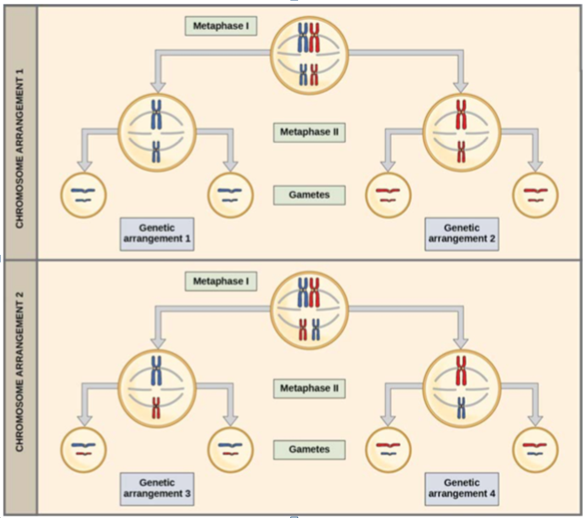Which of the following statements about K-strategists is false?
A. They reproduce quickly.
B. They produce few offspring.
C. There is a lot of parental investment in the
offspring.
D. They evolve in stable environments.
E. They evolve in environments with intense
competition for limited food.
A
You might also like to view...
During meiosis, pairs of homologous chromosomes line up at the metaphase plate where they attach to kinetochore microtubules and are drawn to opposite poles of the cell. The selection of chromosomes from each pair is essentially random and accounts for much of the immense variety of traits displayed by sexually reproductive organisms, as illustrated in this diagram. Despite a similar division of genetic material between daughter cells in mitosis, no shuffling of chromosomes occurs. What accounts for this difference between meiosis and mitosis?

a. During mitosis, only a single combination of chromosomes is possible due to a slight polar charge that is absent during meiosis.
b. During mitosis, only a single combination of chromosomes is possible due to enzymes that arrange chromosomes in order.
c. During mitosis, only a single combination of chromosomes is possible because no recombination occurs and the homologs are never separated.
d. During mitosis, only a single combination of chromosomes is possible because nonconforming cells trigger an immune response.
What is the most abundant animal in soft-bottomed communities?
a. Whelks b. Brittle stars c. Polychaetes d. Mussels
Which of the following is NOT a valid difference between traditional and modern forms of biotechnology?
A) Modern biotechnology can isolate and manipulate individual genes. B) Traditional biotechnology was based solely on selective breeding. C) Modern forms of biotechnology are slower than traditional forms of biotechnology. D) Traditional biotechnology can produce cloned animals with new genes.
In a large population of randomly breeding organisms, the frequency of a recessive allele is initially 0.3. There is no migration and no selection. Humans enter this ecosystem and selectively hunt individuals showing the dominant trait. When the gene frequency is reexamined at the end of the year, __________.
a. The frequency of the homozygous dominants will go down, the frequency of the heterozygous genotype will go down, and the frequency of the homozygous recessives will go up b. The frequency of the homozygous dominants will go down, the frequency of the heterozygous genotype will go up, and the frequency of the homozygous recessives will remain the same c. The frequency of the homozygous dominants will go down, the frequency of the heterozygous genotype will remain the same, and the frequency of the homozygous recessives will go up d. The frequency of the homozygous dominants will go up, the frequency of the heterozygous genotype will go down, and the frequency of the homozygous recessives will go down e. The frequency of the homozygous dominants will go up, the frequency of the heterozygous genotype will go down, and the frequency of the homozygous recessives will go up